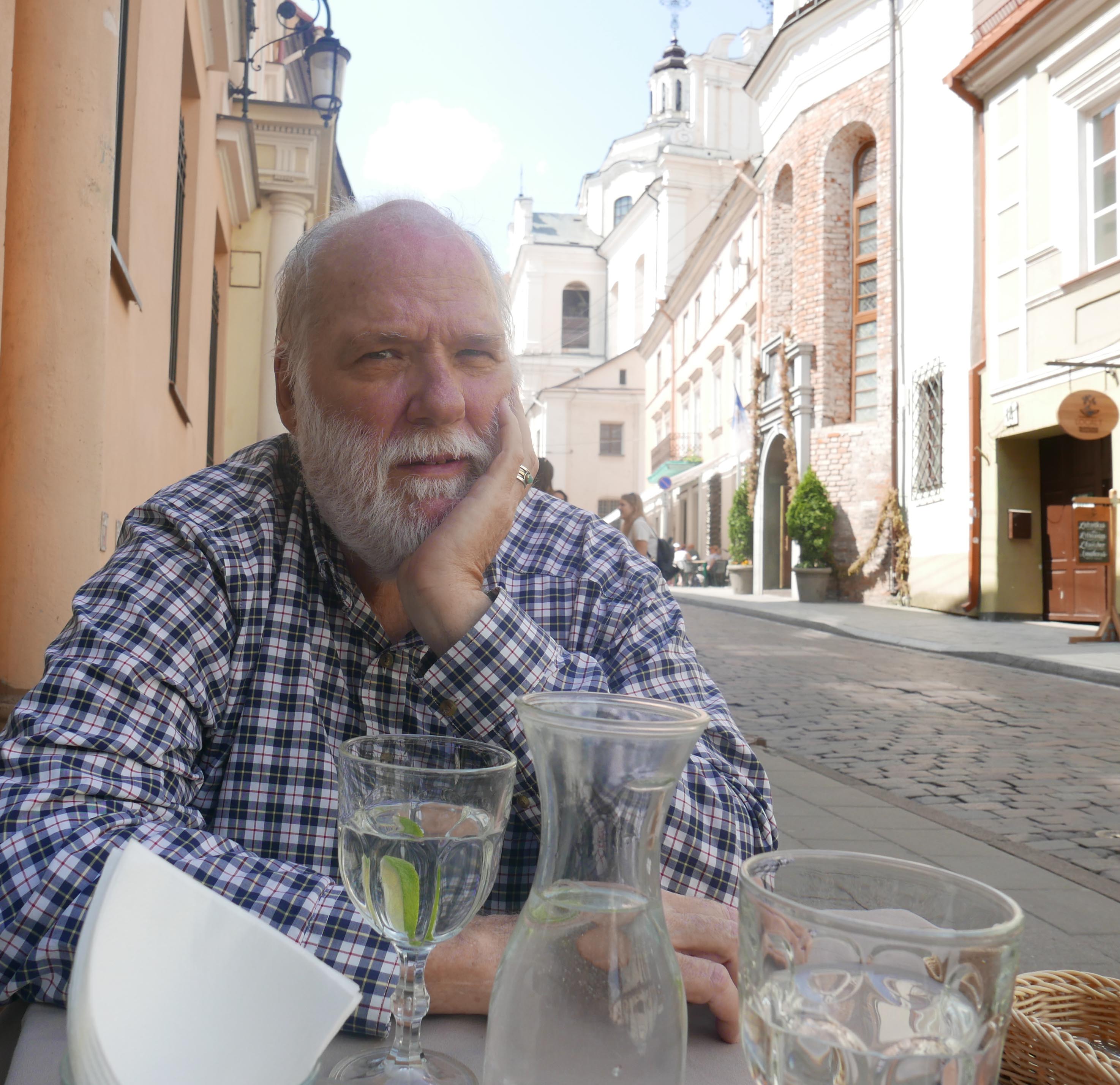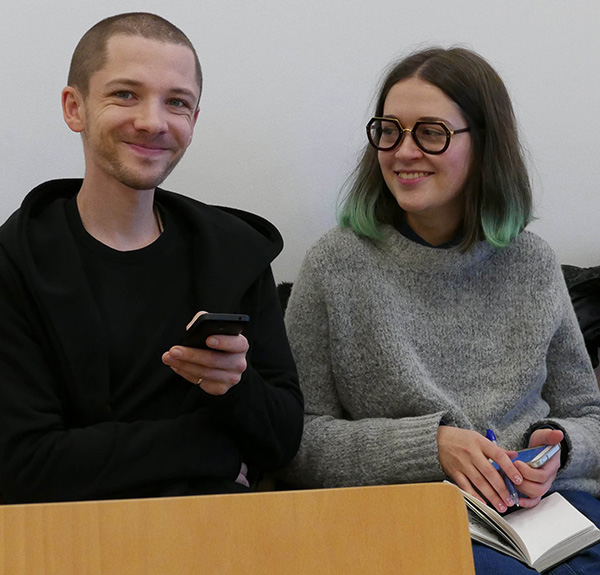Curator Focuses New Course on the Practical Dimensions of Being a Professional Artist
 Students in Dr. Briggs' class at the Vilinus Academy of Arts
Students in Dr. Briggs' class at the Vilinus Academy of ArtsPeter Briggs, the Helen DeVitt Jones curator of art at the Museum of Texas Tech University, traveled to Vilnius, Lithuania in 2016 for six months as a Fulbright Scholar at the Vilnius Academy of Fine Arts. Dr. Briggs developed a course to teach the practical, curatorial and business-side of art to visual artists. This is his second Fulbright Scholar award. His first, at the Academy of Fine Arts and Design in Bratislava, Slovakia, planted seeds for the Museum's Artist Printmaker/Photography Research Collection.
M Magazine: Why did you choose Lithuania for your Fulbright?
Peter Briggs: Lithuania, actually the entire Baltic area, I found interesting. I knew that contemporary art was quite dynamic in the Baltic States. Over the last 20 years, since the Berlin Wall came down, I've developed an interest in central and eastern European visual arts. And I was interested in an area of the world where I've never been. I'm attracted to places that I don't hear people talking about. I often hear about the art scenes in Paris, Berlin, Singapore and other large urban centers, but not a lot about Vilnius. Also, when I contacted educational institutions for my Fulbright application, I received a speedy response from the international program at the Vilnius Academy of Arts. That was encouraging. I was also interested in Bulgaria and Estonia, but the people at the Academy in Lithuania were so open and friendly and informative, that I felt welcome right away.
M Magazine: You developed a new course as part of your Fulbright. Why did you focus on the practical side of art?
PB: I'm really interested in transferring the knowledge of the museum craft or profession, especially curatorial knowledge, from the museum to wider publics. I'm an art curator, have been for 40 years, so I'm particularly interested in taking the knowledge and skills I've developed as a curator and transferring that knowledge and those skills to working artists. They can use the information to advance their own agendas. It's challenging to me to develop that kind of program because the agenda of a working artist is radically different than the agenda of a curator. The course I developed is called Professional Curatorial Practices for Studio Artists.
I teach curatorial methods in the Museum of Texas Tech's museum science graduate program and I've been a curator for decades, primarily in university art museums. As a result, I've worked with a lot of artists and I knew there was a need for this new course. I have never encountered a course quite like this and I investigated to see if there were other models. One challenge I faced was developing a viable syllabus and then justifying the class within the Lithuanian environment. I had to demonstrate the relevance to students there. Actually, this wasn't too hard because the art world has a global reach. Interestingly some faculty at the Texas Tech School of Art were interested in my teaching the class once they saw the syllabus. Perhaps that is one measure of the course's relevance.
M Magazine: What sort of curatorial skills does an artist need?
PB: Artists are faced with serious conflicts between creating works of art and then getting those works of art out into the public—into galleries, museums, exhibitions, collectors, art centers, art fairs and more. Artists are trained to make art; it's what they do. But taking their art out into the world so people can see it, understand it, interpret it, research it, whatever the case may be, takes another skill set. These skills are standard fare in museums. Museums deal with questions such as how do you take care of the art, how do you store it? Your studio is now full and you rent a storage unit, but what are the issues involved? It's not just paying the rent. It's also climate control, insect control, dust control. All sorts of things. The artist has the same problems of preservation that face a museum curator.
Artists also need to know how to communicate with gallerists, collectors and museum curators. I bring to the artist a whole series of techniques to approach curators and people who run galleries. I can teach what kind of information those people looking to receive from an artist. What is the most effective way for the artist to present herself or himself? Artists need to know how to effectively talk and write about their work. How do they contact the media, what media are best to contact? Who is the audience for the artists' work and how do artists reach them? How do I best keep records on my art work and what type of records ought artists keep?
Often time, especially in last 20 years, more and more artists are acting as curators as they organize exhibitions of their own work or organize group exhibitions. What about packing and shipping? If you have a show in Italy and you live in Denmark, how are you going to get your work to Italy? How long will it take to get there? What kind of insurance does the artist need while the work is in transit? Who will pack or crate the artworks? If the work is shipped outside of the Euro zone, what sort of import and export documents do artists need? Taxation, legal predicaments, copyright, publication, photographic and written documentation, the list is long. These are all practical matters that artists need to consider. Most artists cannot afford to hire a professional to handle these matters. So, the course is about addressing these types of issues and skills.
 Students in Dr. Briggs' class at the Vilinus Academy of Arts
Students in Dr. Briggs' class at the Vilinus Academy of ArtsM Magazine: How did you like teaching in a different country?
PB: The European Union nations have developed a higher education program, the Erasmus Program that opens up the higher educational system and minimizes political borders. One of the great advantages of the program is that I get to learn and interact in a small class environment with 20-plus students for all over Europe. In my class I had students from more than 12 different countries. I get to understand how these students conceptualize the world, what is interesting to them in the visual arts, what are the dynamic issues at play in their country. It's a wonderful process and provides an environment that is educationally and culturally rich.
M Magazine: What do personally get from a Fulbright?
PB: First of all, the review and award process that approves my proposal confirms that there is some degree of acknowledgement by other scholars in the world that my project is a significant contribution to learning. Then, the interaction with the students is one of the most incredible dynamics involved in this program. While in Vilnius, I learned not just about Lithuania but from the array of students in my class, about Poland, Belarus, Italy, Spain, Netherlands, Finland and more. While on a Fulbright, you also represent your academic institution and I was aware that I represented Texas Tech and the U.S. So to use an over-used word, I became an ambassador. And I quite enjoy getting out and interacting with people from another country. I took advantage of a wide range of opportunities to meet artists, discuss issues with art administrators, attend art symposia and meetings, go to lectures and poetry readings and even review and interview Lithuanian applicants for grants from the U.S. State Department.
M Magazine: In addition to developing the course, what else do you hope comes from your Fulbright experience?
PB: Many things. One expectation is an increase in the relationship between the Artists Printmaker Research Collection at this Museum and other artists and institutions in Europe. I am hoping that this will manifest itself in both exchanges of tangible exhibitions as well as online exchanges of resources. I want to curate, for example, an exhibition of some of the work in the collection, perhaps printmakers from Texas, that travels to European museums and galleries. Funding is always an issue with such projects.
Since I teach a class in the Museum of Texas Tech museum science program, I have integrated more of an international perspective into my teaching. If there are students who want to explore museums or art schools in Europe, I can help them with the tools to guide that exploration. In Europe art is generally not taught in the universities but in art academies and, as a result, art students there are highly focused on being professional artists. The educational situation is quite different from that in the U.S. and the demands on art students are quite intense.
Such international experiences are always helpful in remembering that the way things are done in the U.S. are not the only way to do things. It's important to integrate points of view from other parts of the world. If you are a Fulbright scholar or a student, you become part of a community. You meet other Fulbrighters at embassy and other functions while you're away and after you return to the U.S this community remains in place as a social network and that makes it even more meaningful in the long term.
Office of Research & Innovation
-
Address
Texas Tech University, 2500 Broadway, Box 41075 Lubbock, TX 79409 -
Phone
806.742.3905 -
Email
vpr.communications@ttu.edu
